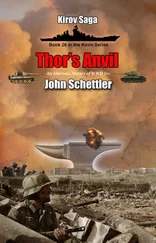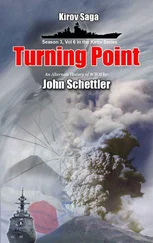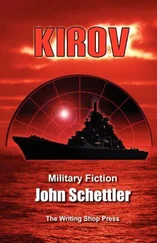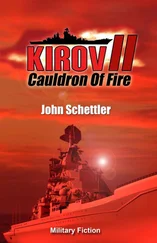John A. Schettler
Kirov Saga
MEN OF WAR
“The death of God left the angels in a strange position.”
~ Donald Barthelme
OnDecember 30, 1980 the Baltiysky Naval Shipyard in Leningrad was a very busy place. It was the day the first of a new fearsome naval surface action combatant, the nuclear guided missile battlecruiser Kirov was slated to be commissioned into the Soviet Navy, the first of four planned ships in this class. It would be some time before the Western analysts and intelligence experts who watched from a distance would really take the measure of this awesome new ship. In its early months in the Baltic NATO planners had taken to calling it BALCOM-1 for “Baltic Combatant 1.” Once they got a look at the ship they hoped it would be the last they would ever see of this class, but Soviet Russia would not oblige.
Bristling with vertical launch missile ports, SAMs, and deck guns, the ship promised to upset the balance of power in the Northern Seas and, for the Royal Navy, there had not been a ship this feared and respected since the launching of the German Bismarck class battleships in the Second World War. One man who watched the reports saw the satellite and high altitude U-2 photos was Captain Peter Yates, British Naval Intelligence. The rumors of the ship had already set analysts into worry mode since it first hit the Soviet naval designer’s drawing boards in the mid 1970s. Yates had been one of the privileged few to see the drawings and early photographs of the ship in the naval yards. Something about the scale and design of the ship immediately set off a thrum of anxiety. Kirov would be over 827 feet long with a generous beam of 94 feet and displace 28,000 tons fully loaded. While half the weight of a respectable World War II class battleship, she would have the power to confront and sink an entire fleet.
A young man in 1980, Yates was recruited into a dark program hidden deep within the wandering the hallways of the Naval Board at Whitehall. He would not even learn what it was for some years, and then one day he would be escorted into a windowless room handed a sheaf of files with photography and transcripts and told he was to see the British Royal Navy Admiral Of The Fleet immediately after he had reviewed the material. Captain Peter Yates, whose surname meant ‘dweller by the gate,’ or the gatekeeper, was about to receive a promotion and become Commodore Yates. He would be admitted to a very select group of men known only as the Watch, and told he would have more than his fair share of long years to stand if he accepted the post, and be privy to intelligence matters with the highest possible clearance. He accepted, and was soon surprised to learn that his post would relate directly to the photographs he had studied before the meeting. His watch would be on that very ship, Kirov , and he would need to know its movements, whereabouts and status at all times.
On December 30, 1980, he also got his first look at the dark history of this vessel. There before him were photographs, gun camera footage, and other video related to a top-secret event known only as the “ Geronimo incident” dating from World War II. To his great surprise that December the ship he saw cruising quietly into the Baltic Sea was the image and likeness of the ship he had seen in those secret files! The phantom that had haunted the opera of British intelligence for the last forty years had finally taken shape in the real world, built by the hands of men.
Yates did not know then that this was not the ship that confronted the Royal Navy in the North Seas in 1941, and again in the Mediterranean of 1942. There were subtle differences, but it’s lines and specifications were so close that the first Kirov became the most watched ship of its era, with a British submarine assigned to dog its movements for each and every second of its brief ten-year active service life.
When the ship finally suffered a reactor accident in 1990 during a Mediterranean cruise, and was taken off the active-duty list, Yates released a sigh of relief. Now the ship would at least be kept in one place for a time where British Intelligence could keep a watchful eye. There it sat, rusting away in the cold Arctic North while Yates watched the three others of its class suffered similar fates. They were all given new names and one by one they fell out of active service.
Admiral Lazarev sat in the Bay below Russian Naval Pacific Fleet Headquarters at Fokino near Vladivostok, and Admiral Nakhimov sat in Severodinsk. The last of the four, battlecruiser Pyotr Velikiy, or Peter the Great , remained in active service into the year 2015 when it was also retired. The dread battlecruisers were finally off the world stage and no longer a threat until the year 2018 when the new Russia resurrected its promise to refit and reactivate all four of these formidable ships by the year 2020. They made the deadline, but produced only one such ship, built from the bones of all the others that had come before it. And to honor the original class they gave that ship back its old name and called it Kirov .
In that year, forty-four years after its original design took shape and form, the new updated battlecruiser Kirov returned to the northern seas, making a brief training cruise in the year 2020 and then taking a proud place at the head of the Soviet Northern Fleet as its new flagship. By that time, Commodore Yates was now Admiral Yates, a man of sixty-four years, yet young for his age with just a touch of gray at each Temple and the tall sturdy frame with sharp dark eyes that seemed to notice everything when he entered a room. Yates was now the senior officer in charge of the group known as the Watch, one of many such men and women scattered throughout the world in key positions still keeping a vigilant eye on world events.
2020 had been a jarring year. Kirov was back. That was the great worry once again. Now that the ship had returned to active duty service with new electronics, engines, and deadly new weapons, Kirov once again posed a grave threat to the sea lanes Western navies and their vast fleets of commerce ships depended on. But it was not what Kirov might do to a present-day ship in the year 2021 that so bedeviled the Watch this time. It was what the ship might do to the navies of an earlier time, for now this shadowy group was convinced that this second rebirth of the dread battlecruiser was indeed the ship their founders had come to call Geronimo .
Yates knew that, one day, on some mission, perhaps a routine cruise for training or simply to show the flag at distant ports of the world, this ship would simply vanish. What it would do to the history of the world after that moment would make all the difference between survival and the utter destruction of the entire human race. So just like it’s older brother before it, the ship could never sail outside the purview of the Royal Navy. A submarine was assigned to intercept and shadow the Russian battlecruiser at every moment, and a special emergency communications device was installed on that sub that would immediately signal level one critical alert should the sub ever lose contact with the ship. The Royal Navy, and the men of the Watch, wanted to know the exact moment in time that the ship was first displaced to a distant era where now legendary figures like Admiral John Tovey and men like Alan Turing of Bletchley Park had first grappled with the deep mystery of the ship’s sudden appearance in the middle of World War II. Now, at long last, they were to have their answer.
On a late summer night in July the telephone was ringing in a lonesome and largely unknown office of Royal Navy Headquarters at the Maritime Warfare Centre, Whale Island, Portsmouth. This was the old Coastal Command Headquarters that was eventually expanded to take over joint operations for air/naval operations for the United Kingdom and related NATO affairs. Home to a staff of 1600 men and women, the main buildings were simple four story offices with long rows of windows and little architectural appeal, but when something really dicey went down, the deep underground secure bunkers were in operation to coordinate events, as they soon were that day when the alert first came in.
Читать дальше












